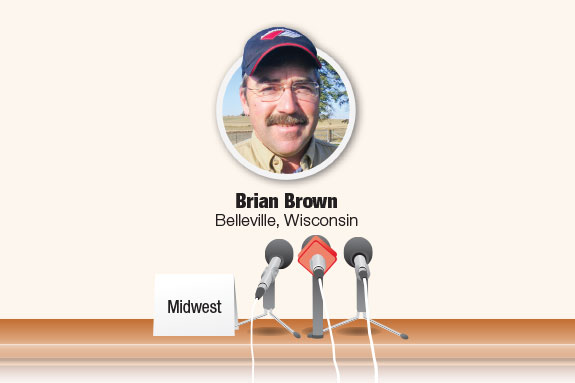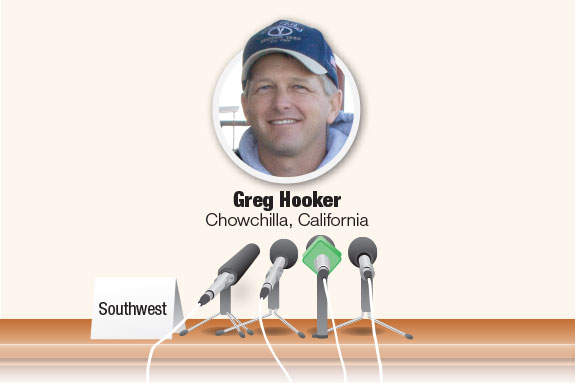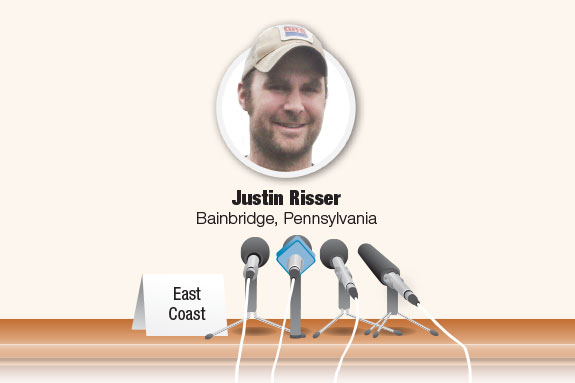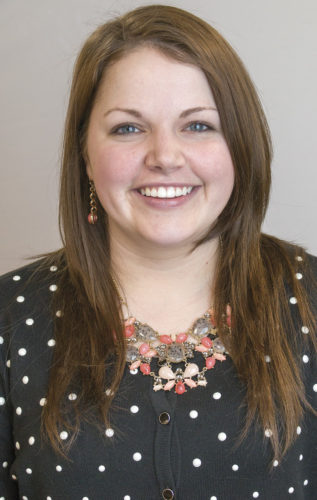This article is the second in a series of roundtable discussions where three forward-thinking producers share protocols and lessons learned. This article features: Greg Hooker of Diamond H Dairy in Chowchilla, California Brian Brown of Sunburst Dairy in Belleville, Wisconsin Justin Risser of Meadow Vista Dairy in Bainbridge, Pennsylvania

Tell us about your reproductive management program. How have you set up your breeding program?

BROWN: Our program consists of double Ovsynch and implementing a resynchronization program. After the second insemination, if they are not confirmed pregnant, a CIDR (controlled internal drug release device) protocol is used.
We are using an average 73-day voluntary wait period with first pregnancy check at an average 39 days post-insemination. Confirmed pregnant cows are reconfirmed at 80 days post-insemination.
HOOKER: Our herd uses a timed-A.I. program in conjunction with heat detection. After a 50-day voluntary waiting period, we heat detect using tail chalk and breed until about 80 days, when any cow not pregnant is time-bred using a Cosynch (lact>1) or a CIDR-synch (lact=1) program.
All of our milking pens are A.I.-bred except our low strings, which includes only “do not breed (DNB)” animals and pregnant animals. The only bulls on the dairy are in our cleanup virgin heifer pens.
RISSER: We have our cows set up on a Presynch and Ovsynch program. More than 95 percent of the cows go through the entire five-shot regimen to be bred between 75 and 82 days in milk (DIM). We choose not to cherry-pick of the prostaglandin (PG) shots because first-service conception runs about 48 percent year-round, 57 percent in 2-year-olds alone.
We do not do cleanup checks on any of the cows prior to setup shots or breeding. Cows with a retained placenta at calving get a series of two prostaglandin shots two weeks apart prior to starting Presynch to aid in cleanup. From service date to pregnancy check is a minimum of 33 days for both cows and heifers.
We use CIDRS for cows diagnosed cystic and only re-synch cows that have pregnancies that look terminal at first check. These animals are followed up with the following week and either confirmed OK or open. If open, PG is administered so we can breed in three days and not lose any time.

How do you manage your animals from when they’re confirmed pregnant until freshening?
BROWN: Cows are in groups by lactation. They stay within that group throughout the lactation. Cows are dried off at about 55 to 60 days before calving. Then about three weeks before calving, they are moved to a pre-fresh area.

HOOKER: Once a cow is confirmed pregnant, very little changes. The grouping strategy on our dairy is very simple. We group fresh heifers together, fresh cows together, first- lactation animals together, high cows together and low cows together. The animals are not moved based on their pregnancy status unless they are 195+ days carried calf (DCC) and nearing dry-off.
RISSER: When cows are checked pregnant, they are not forgotten. If they are pregnant with twins, they are re-checked in two weeks (approximately 47 to 54 DIM) to make sure they are still safe with calf. If they are pregnant with just a single fetus, they are re-checked at 70 days and then again at 150 days as a dry-off check.
Cows with twins are treated the same after that second initial check, getting checked at 70 days and 150 days. Cows with twins will get a full 60-day dry period while single-calf cows are given a 50-day dry period if milking well.
Finally, cows with twins are put into the springer group one week longer than single-calf cows. This move is done mainly to get them on the higher energy springer ration and on the DCAD so that if they calve early, they are more likely to have a smoother transition.

Who forms a part of your farm’s reproductive management team?
BROWN: We have a female herd manager that oversees the animals and protocols and does A.I. work. My wife does herd checks and enters information into Dairy Comp . I work with sire selection and A.I. work. We work with our nutritionist, James Bailey, and veterinarian, Dr. Berry Kleppe and the Waunakee Vet Service. We also work with Jason Goke with Accelerated Genetics for relief A.I. work.
HOOKER: The main members of our reproductive team include our veterinarians, several herdsmen and a couple of custom breeders. Of course, nearly all of the employees are important when it comes to reproduction.
The correct vaccines need to be administered throughout the cow’s life, the calving barn crew needs to make sure the cow calves with minimal complications, the fresh cow crew needs to make sure the cow makes a great transition, the feeding crew makes sure cows are fed the right ration at the right time and the freestall crew ensures that the cows are as comfortable as possible.

RISSER: Our reproductive team consists predominantly of four people. Tanya, my assistant herd manager, administers 95 percent of the shots, enters diagnoses into the computer and keeps all the records straight and orderly. I do most of the heifer breeding, cow breeding, and ultrasound work with our own farm unit we purchased three years ago.
A technician breeds our Ovsynch group on Fridays, while Justin finishes fresh cow work to make sure cows aren’t in lock-ups too long. Finally, our veterinarian, Dr. Brian Reed, helps with reproductive troubleshooting and stops in once a month to palpate a few cows and see how things are going.

What method is used to diagnose pregnancies in your herd?
BROWN: We use ultrasound to diagnose pregnancies in our herd.
HOOKER: The cows are first detected pregnant between 28 and 35 days with a blood test. This is a recent change we have made at the dairy. Prior to September we were vet checking with ultrasound half of the herd each week or each pen once every two weeks (this means cows were checked between 28 and 42 days). We were also giving cows GnRH the week before vet check to set up the open cows for resynching.
Now we draw blood once per week from each pen. In a lot of ways this has simplified our program. Since we check the whole herd each week, we save some GnRH in addition to catching open cows a little earlier.
RISSER: Ultrasounding is done at 33 days for both cows and heifers. We have gone down to 28 days in heifers, but found we had a level of open heifers at 70 days that we were unhappy with. Since switching back to 33 days, we have only found a handful open at 70 days in the last two years.

What heat detection method is used on your dairy?
BROWN: A synch program is used along with visual signs. We do a lot of visual watching for estrus and watching for discharges, alertness and mounting. Cows that have CIDRs will be tail-chalked. All cows are run through the entire double Ovsynch program.
HOOKER: We use tail chalk for heat detection.
RISSER: All heat detection is done visually on the farm. We watch cows twice a day and heifers once a day for heat. However, Justin, Tanya, and Justin’s father, Gerald, catch many cows throughout the day as they walk to and from the parlor just doing chores around the barn.

Discuss your heifer-raising program from a reproduction standpoint.
BROWN: Our heifers are raised off-farm during this time period. Growers implement sound nutrition and housing programs. Animals are monitored for proper growth and bred at 13 to 14 months. Visual or tail chalking is utilized and assistance programs are used when needed.
HOOKER: Our heifer facility has two to three pens of 250 heifers each that are monitored for heat detection and breeding at any one time. Each of the pens has 100 percent lock-ups. We tail-chalk every heifer when she enters the breeding pen. We will hold back small heifers, if necessary. We use sexed semen on all first-service heifers. The second service we will breed A.I. with proven conventional bull semen.
We will breed cycling heifers who show heats until they are 17 months old, at which point we cull them if there has not been a conception to that point. If a heifer is confirmed pregnant at preg check but aborts within the first 100 days of the pregnancy, she is re-submitted for breeding in a bull-bred heifer cleanup pen. Bulls are only used in this pen.
( Click here for additional details about heifer breeding protocol at Diamond H Dairy.)
RISSER: Heifers are looked to be serviced when they are 13 months old. Some that are ahead in size can be serviced at 12.5 months. We administer prostaglandin every week to the open heifers at check (if they possess a corpus luteum) and to those of age and not yet seen in standing heat.
If we give PG and see no response, that heifer will be skipped next week and then given prostaglandin the following week. We do not give PG less than 14 days apart. Heifer pregnancy rate runs a consistent 50 percent. First-service conception with this technique is 71 percent, with overall conception at 67 percent.

What is your herd’s genetic selection process?
BROWN: All animals are mated using Accelerated Genetics’ GEM program. Animals that calve in are visually mated and the rest are pedigree-mated with updates at sire proofs. We focus on feet and legs with emphasis on milk and components. In the first two services, we are using proven sires and then we use PACE sires, a young sire-proving program through Accelerated Genetics.
HOOKER: I have in the past just picked some good A.I. bulls (7 to 10 in the top 15 percent) and bred all cows to those. I was expanding the herd rapidly and had to buy a lot of animals off the open market. I didn’t have much pedigree information on the herd so I just wanted to get a better pool of genetics in them.
RISSER: We pick bulls that we believe will deliver us the best heifers for our freestall system. We look for milk (+700 pounds) and like to see at least a point in overall type, udder composite and feet and legs. We try to not pick negative DPR bulls but will sacrifice if they are a high production bull.
We like a positive productive life coefficient. For heifers, we choose calving ease bulls of 6 percent or less to breed with. All cows are mated by Genex after calving and before first service. This has delivered a consistent heifer pen in both size and functionality – something the milking crew really appreciates.

What change have you made to your reproductive program in the past that has improved your farm’s profitability?
BROWN: Utilizing the double Ovsynch program along with a longer wait period has worked well for us. Indirectly we have worked with Nigel Cook ( University of Wisconsin – Madison School of Veterinary Medicine ) on cow comfort and James Baily on heat abatement and animal nutrition.
We also implemented a two-time-per-lactation foot trim. If a cow feels better, she eats more and shows stronger heats. We feel it has had good returns including reproduction.
HOOKER: Since 2010, I have had a closed herd and have a lot more genetic information.
RISSER: Purchasing our ultrasound equipment has saved us thousands of dollars a year. I can do the pregnancy checking for much less than a licensed veterinarian. We have found that we have not sacrificed anything reproduction-wise, as far as diagnoses, finding twins, failed pregnancies and determining ovarian structures.
Additionally, having the same person palpate the cows every week has its benefits, much like having the same person mix the feed on a daily basis. It’s about noticing reproductive trends and how to avoid repeating slumps.

Is there an area in your reproductive management program that you are currently working to improve?
BROWN : At this time there isn’t anything major we are working on, but we are always tweaking and evaluating something. Last year it was our thaw bath procedure.
HOOKER: The one thing I would like to develop this next year would be a mating program of some sort. This will include mating to reduce inbreeding and possibly include using additional sexed semen in heifers and beef bulls in some poorer older animals.
RISSER: We’ve taken left displaced abomasums (LDAs) from 7.5 percent to 1.5 percent over the last three years. Retained placentas used to stand close to 15 percent a few years back; now we run less than 3 percent for primary RPs. Dry cows do not go out on pasture anymore. This helps summer- calving cows breed better in the fall. We’ve seen the results of intense dry cow and springer management show up on preg check days. PD

-
Emily Caldwell
- Editor
- Progressive Dairyman
- Email Emily Caldwell







